![Drew Cook had Big Mo (momentum) on his side as he began the 2020 Elite Series season. âI was coming off my first Elite season [in 2019] feeling superconfident,â he said. âIâd led Angler of the Year point standings through much of the season, won Rookie of the Year and qualified for the Classic. My fiancée [Jennifer McClenny] and I had a big wedding coming up. I knew 2020 was going to be awesome.â Then the coronavirus pandemic hit and Big Mo came to a screeching halt. âThe B.A.S.S. tournament schedule was postponed; we couldnât have that big wedding due to social distancing; and we couldnât even move into the new house weâd closed on.â What a bummer! Cook and McClenny opted to marry in a small ceremony in May, and by June, Elite Series competition had resumed with an event at Alabamaâs Lake Eufaula, where Cook placed fifth. âThankfully, things are turning around. I had a good tournament at Eufaula, weâre happily married and we finally moved into our house. Iâll be heading to New York shortly for three Elite tournaments. And Iâm ready to whack some bass right frigginâ now on this little lake, so letâs get this dang boat in the water!â If youâre wondering where all those shallow bass went now that summer is here, hop aboard as Cook takes on Lake T!
<br><br>
<b>6:19 a.m.</b> We arrive at Lake Tâs deserted boat ramp. Itâs 62 degrees, clear and calm. Fingers of fog creep across the water as Cook prepares his stash of Dobyns rods equipped with Shimano reels for the upcoming challenge. âBeing late June, most of the bass have probably spawned and are reorienting to deep summer patterns. Iâll primarily key on points once the sun gets high, but Iâll start off shallow with a topwater.â
<br><br>
<b>7 HOURS LEFT</B><BR>
<b>6:35 a.m.</b> We launch the Skeeter. Lake T is 82 degrees and stained. Cook immediately drops his trolling motor and begins casting a silver Spro Essential Pop surface lure to the shaded shoreline. âTopwater can score a big fish early in the day in June, and this bait walks, pops and chugs. â<br>
<b>6:47 a.m.</b> Cook switches to a shad colored Spro Essential squarebill crankbait. âSpro wonât be officially releasing this bait until midsummer; I fished this sample at Eufaula and caught a bunch of bass on it. Itâs pretty chewed up!â <br>
<b>6:54 a.m.</b> Cook makes a quick run to Lake Tâs dam and retrieves a 3/8-ounce Nichols Lures buzzbait with a Big Bite Baits Real Deal Shad trailer around riprap. <br>
<b>7:03 a.m.</b> Cook grinds the squarebill across the riprap and catches a nonkeeper largemouth; its belly is bloated with baitfish. âDude, this fish is only 11 inches long but looks like it weighs 8 pounds!â <br>
<b>7:08 a.m.</b> Cook flips a 1/2-ounce green pumpkin/orange/chartreuse Nichols Lures DB finesse jig with a tilapia color Big Bite Baits Fighting Frog trailer at the riprap.](http://www.bassmaster.com/wp-content/uploads/2021/10/06-54_-_dotl_cook2.jpg)
6:19 a.m. We arrive at Lake Tâs deserted boat ramp. Itâs 62 degrees, clear and calm. Fingers of fog creep across the water as Cook prepares his stash of Dobyns rods equipped with Shimano reels for the upcoming challenge. âBeing late June, most of the bass have probably spawned and are reorienting to deep summer patterns. Iâll primarily key on points once the sun gets high, but Iâll start off shallow with a topwater.â
7 HOURS LEFT6:35 a.m. We launch the Skeeter. Lake T is 82 degrees and stained. Cook immediately drops his trolling motor and begins casting a silver Spro Essential Pop surface lure to the shaded shoreline. âTopwater can score a big fish early in the day in June, and this bait walks, pops and chugs. â6:47 a.m. Cook switches to a shad colored Spro Essential squarebill crankbait. âSpro wonât be officially releasing this bait until midsummer; I fished this sample at Eufaula and caught a bunch of bass on it. Itâs pretty chewed up!â 6:54 a.m. Cook makes a quick run to Lake Tâs dam and retrieves a 3/8-ounce Nichols Lures buzzbait with a Big Bite Baits Real Deal Shad trailer around riprap. 7:03 a.m. Cook grinds the squarebill across the riprap and catches a nonkeeper largemouth; its belly is bloated with baitfish. âDude, this fish is only 11 inches long but looks like it weighs 8 pounds!â 7:08 a.m. Cook flips a 1/2-ounce green pumpkin/orange/chartreuse Nichols Lures DB finesse jig with a tilapia color Big Bite Baits Fighting Frog trailer at the riprap.
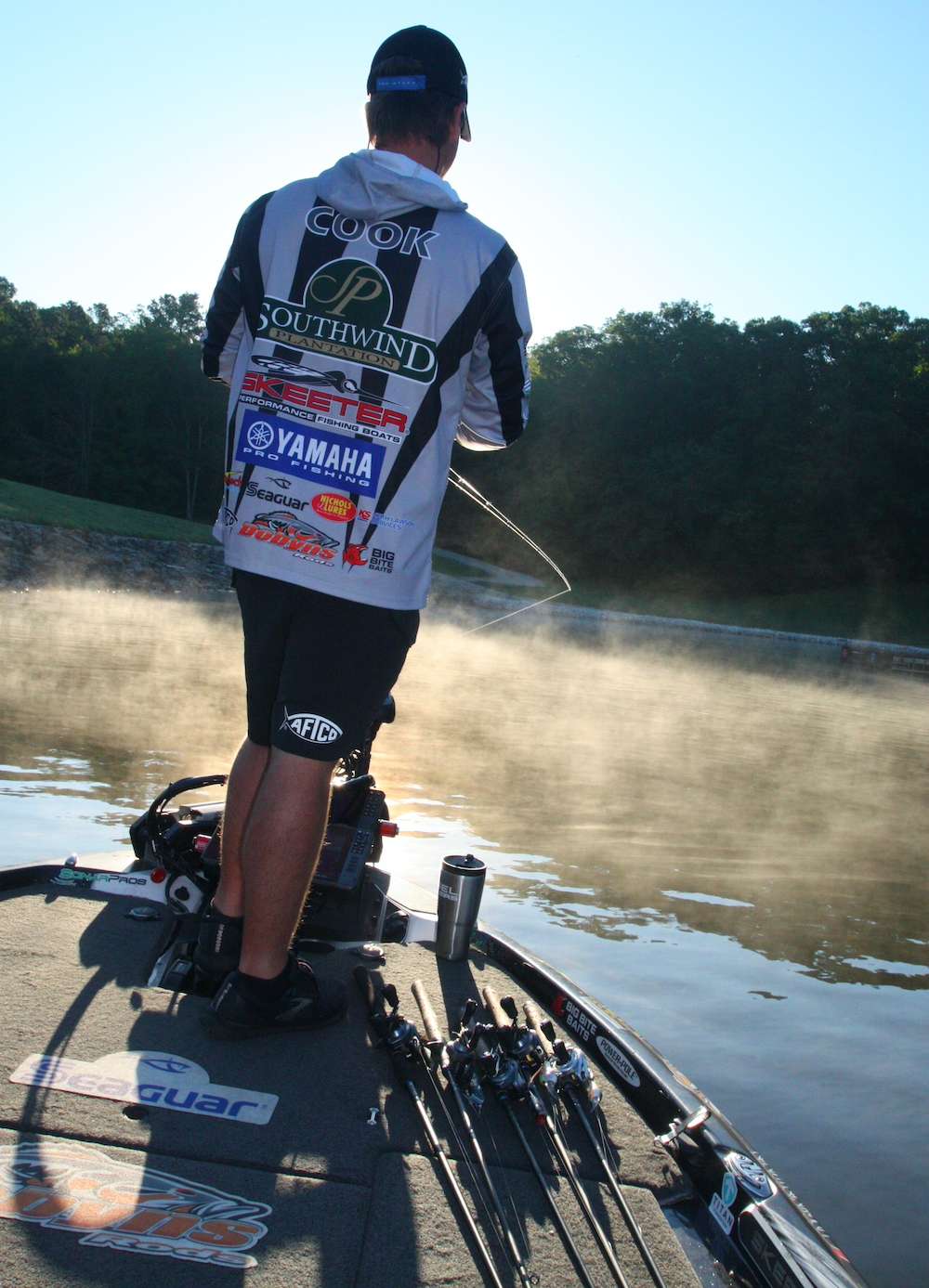
6 HOURS LEFT7:35 a.m. A school of shad surfaces in the cove; Cook walks the Essential Pop through the baitfish. âI have yet to see a bass busting shad on top.â 7:38 a.m. Cook dredges a Spro RkCrawler crankbait in ayu color through the shad.
7:46 a.m. Cook has run uplake to a long rock point at the entrance to a tributary. He tries a Spro Fat Papa 70 crankbait in homemade shad color on the structure.
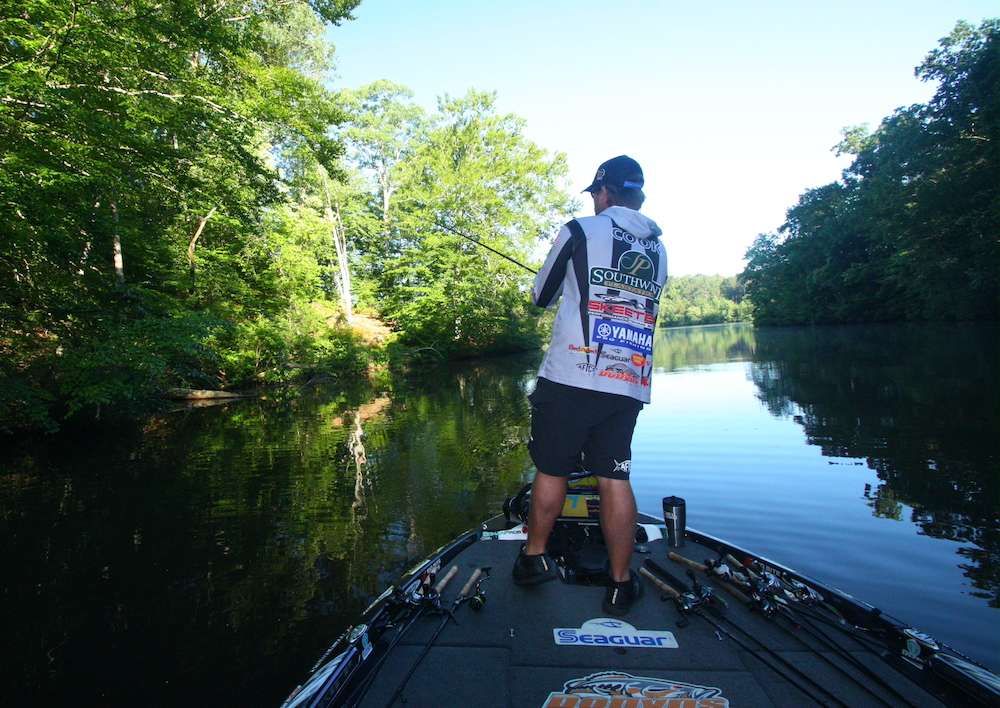
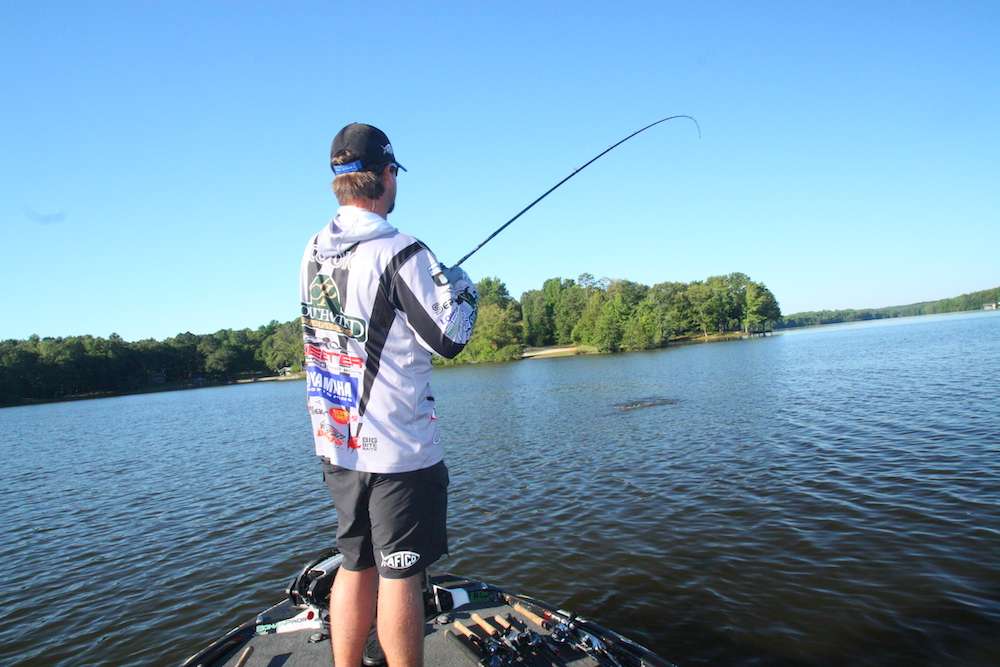
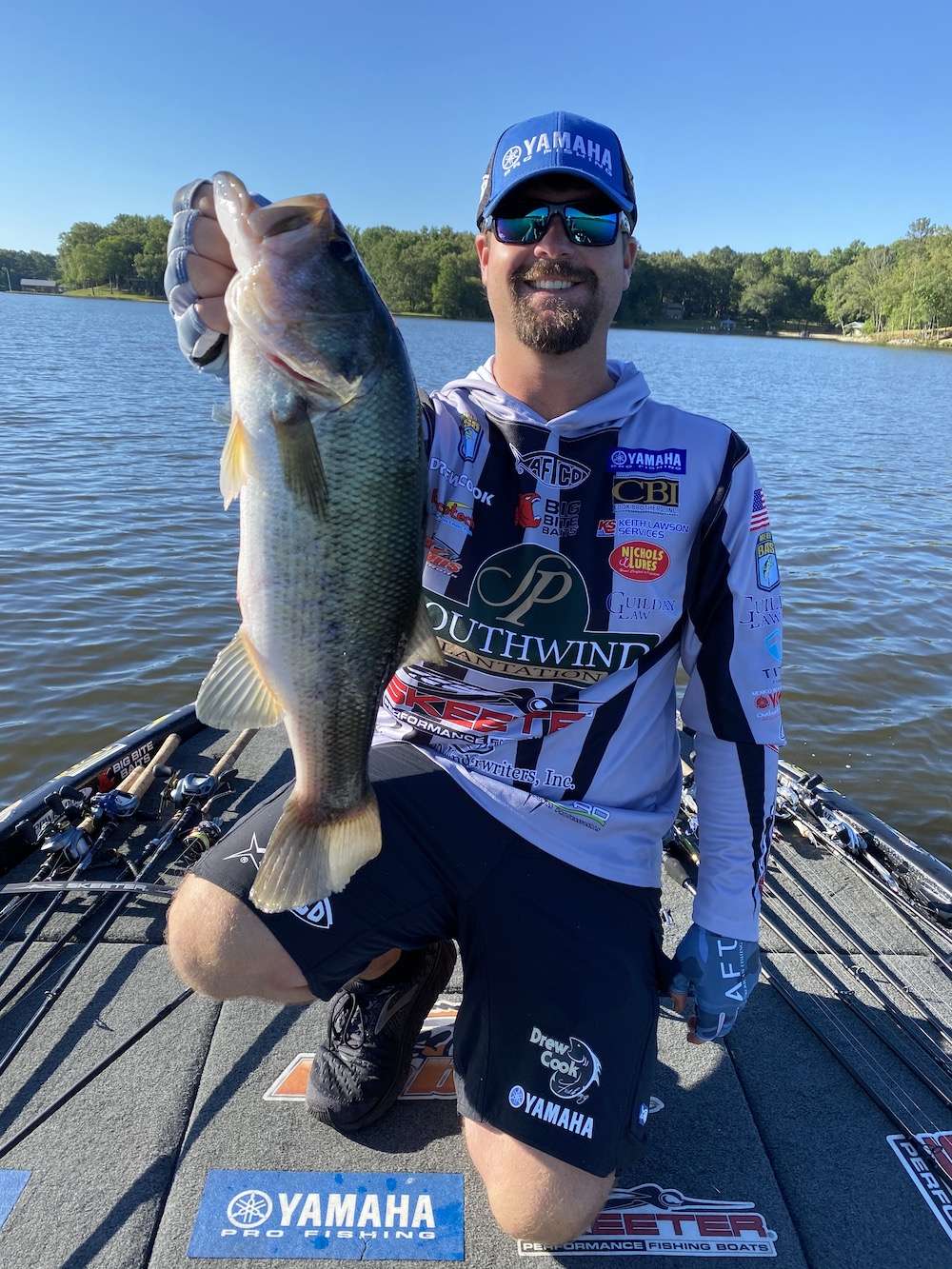
8:18 a.m. Cook has located another big bait school off the point; he hits it with the worm and Fat Papa. 8:28 a.m. The crankbait bite off the point has slowed and Cook is now trying the jerkbait.
5 HOURS LEFT8:35 a.m. Cook has moved deeper into the tributary arm and is now targeting baitfish suspended around an offshore hump rising from 21 to 10 feet with the Fat Papa and worm. Thereâs a light breeze blowing out of the east. 8:47 a.m. Cook is graphing some huge balls of shad around the hump. He hops the jig around the structure without success.
8:54 a.m. Cook abandons the hump and moves to the bank, where he flips the jig around a boathouse. 9:01 a.m. He tries the squarebill around a seawall. 9:04 a.m. Cook switches to a green pumpkin Big Bite Baits Trick Stick finesse worm rigged wacky style, twitching it around a dock. 9:09 a.m. He runs the buzzbait around a shallow pocket but hauls water. âWeâre out of here; I need to get back offshore.â 9:22 a.m. Cook has made a long run uplake, where heâs spent several minutes idling around open water while eyeballing his electronics. Heâs now 50 yards off the end of a mud point. He makes an extra-long cast with the Fat Papa to open water. âIâm going to fish my way up to the point, targeting baitfish schools as I go.â 9:25 a.m. Cook switches Fat Papa colors to citrus shad âbecause the water looks dirtier up here.â 9:32 a.m. A big fish slams the Fat Papa at boatside but gets off. âCrap! That was a 4-pounder!â
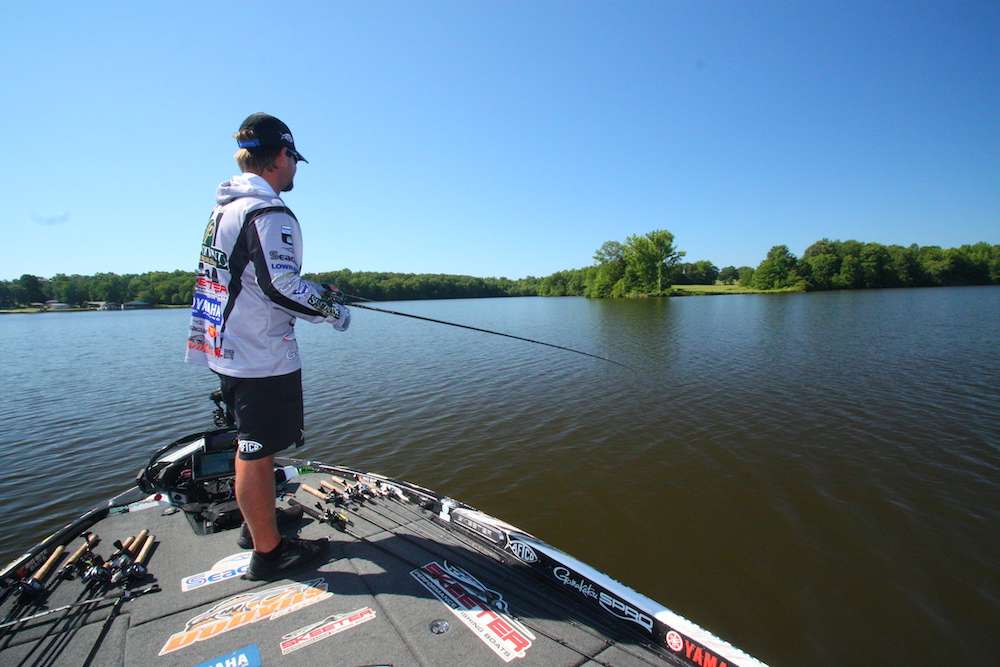
4 HOURS LEFT9:35 a.m. Cook hangs the crankbait in a submerged brushpile. He lowers a lure retriever into the snaggy shrubbery; it also gets hung up and its cord breaks when he tries to jerk it free. âWell, thatâs just great! I lost the whole works!â He ties on another citrus shad Fat Papa and resumes cranking. 9:42 a.m. Cook catches his fifth keeper, 2-6, off the point on the Fat Papa. âGood, now hopefully I can cull those âpoundersâ I caught earlier.â 9:48 a.m. The breeze has died and itâs getting hot as Cook retrieves the big swimbait across the end of the point. 10 a.m. Back to cranking the Fat Papa. Whatâs Cookâs take on the day so far? âThese high-pressure conditions have made the bite pretty slow. I had no luck up shallow, but Iâve found two small concentrations of fish relating to shad schools off two different points. Iâm going to stay with this point pattern awhile in hopes that more fish will bunch up as the sun gets progressively higher.â 10:03 a.m. Cook catches his sixth keeper, 1-12, on the RkCrawler; it culls his 1-pounder. 10:04 a.m. He bags his seventh keeper, 2-6, off the mud point on the RkCrawler; it culls his first 1-2. 10:12 a.m. Cook switches to the 10-inch worm, canât get bit, then reverts to the RkCrawler. 10:20 a.m. Cook has moved considerably closer to the point and is cranking the RkCrawler. âThereâs a lot of baitfish activity near the surface, but Iâm still not seeing any bass chasing them.â 10:24 a.m. He bags a 1-1 keeper (No. 8) off the point on the worm; itâs no help. 10:27 a.m. Another bass hits Cookâs worm; this one pulls free. âThat felt like a good fish.â
3 HOURS LEFT10:35 a.m. Cook hops the jig across the mud point. 10:37 a.m. The RkCrawler scores a short fish off the point. 10:42 a.m. Cook walks the Essential Pop through a pack of surfacing shad and braces himself for the strike that never happens. âYouâd think theyâd bust that topwater plug, but they arenât interested.â 10:49 a.m. Cook moves to a steep channel bank with several laydown trees extending from shore and cranks the squarebill.
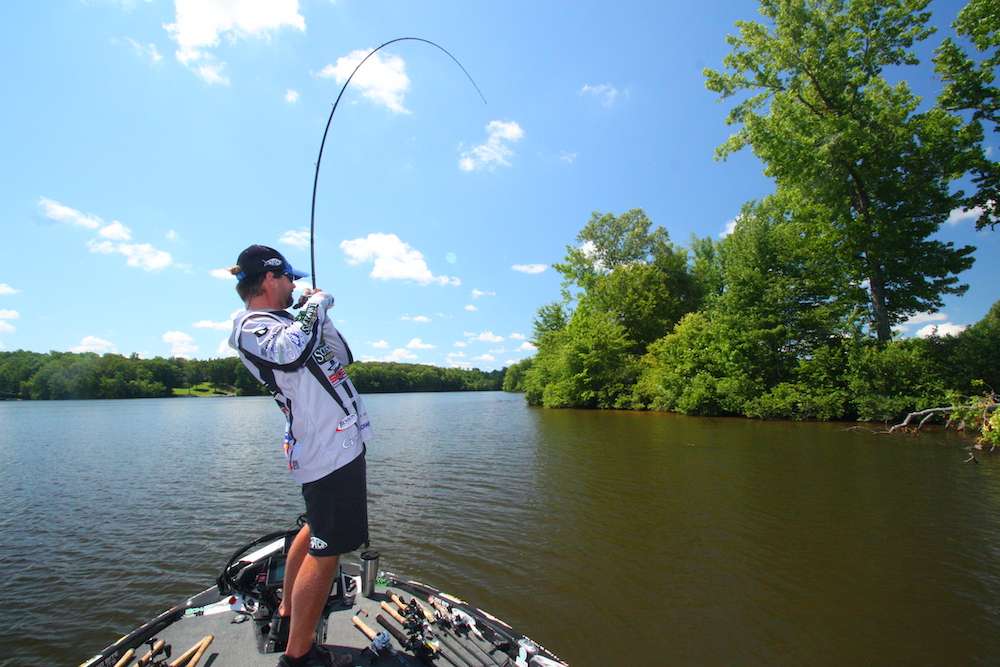
2 HOURS LEFT11:35 a.m. Cook hangs the Fat Papa in submerged brush and retrieves it. 11:39 a.m. He drags the 10-inch worm around the point. 11:46 a.m. Cook makes a blistering run downlake to the rock point he fished earlier. He tries the worm and Fat Papa. 11:52 a.m. He moves closer to shore to crank the RkCrawler around an old boat ramp. âBass love to hang around a gnarly old ramp like this â the more busted-up, the better. At least thatâs what I read in Bassmaster.â 12:07 p.m. Cook moves farther down the bank and cranks the squarebill. 12:10 p.m. Cook cranks up a submerged limb. âTree-pounder!â 12:22 p.m. Cook roars back uplake to the mud point he fished earlier. He drops his trolling motor 100 yards from the structure and begins fishing his way toward it with the Fat Papa. 12:24 p.m. Cook casts the 10-inch worm to a submerged brushpile. A fish bumps the crawler; he swings back his rod, and the bass spits it out. âThatâs another good fish Iâve lost on the worm! Theyâre just not hanging onto it.â 12:28 p.m. Another tap, another swing, another miss with the worm. âUnbelievable!â
1 HOUR LEFT12:35 p.m. Cook catches his 10th keeper, 2 pounds, 14 ounces; off the mud point on the Fat Papa. 12:49 p.m. Cook bags keeper No. 11, 2 pounds, 15 ounces, on the RkCrawler.
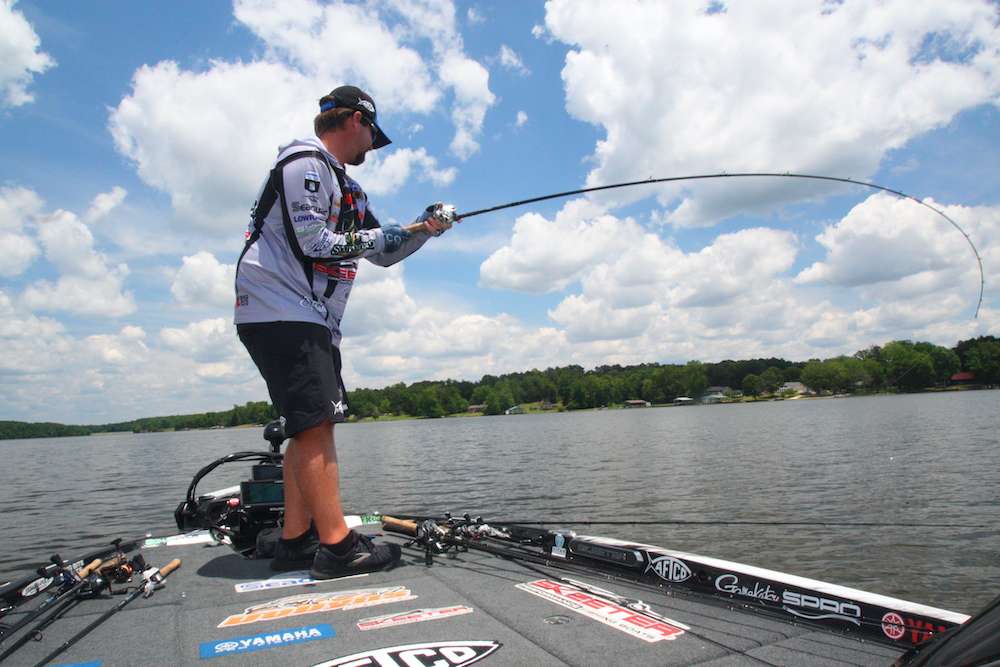
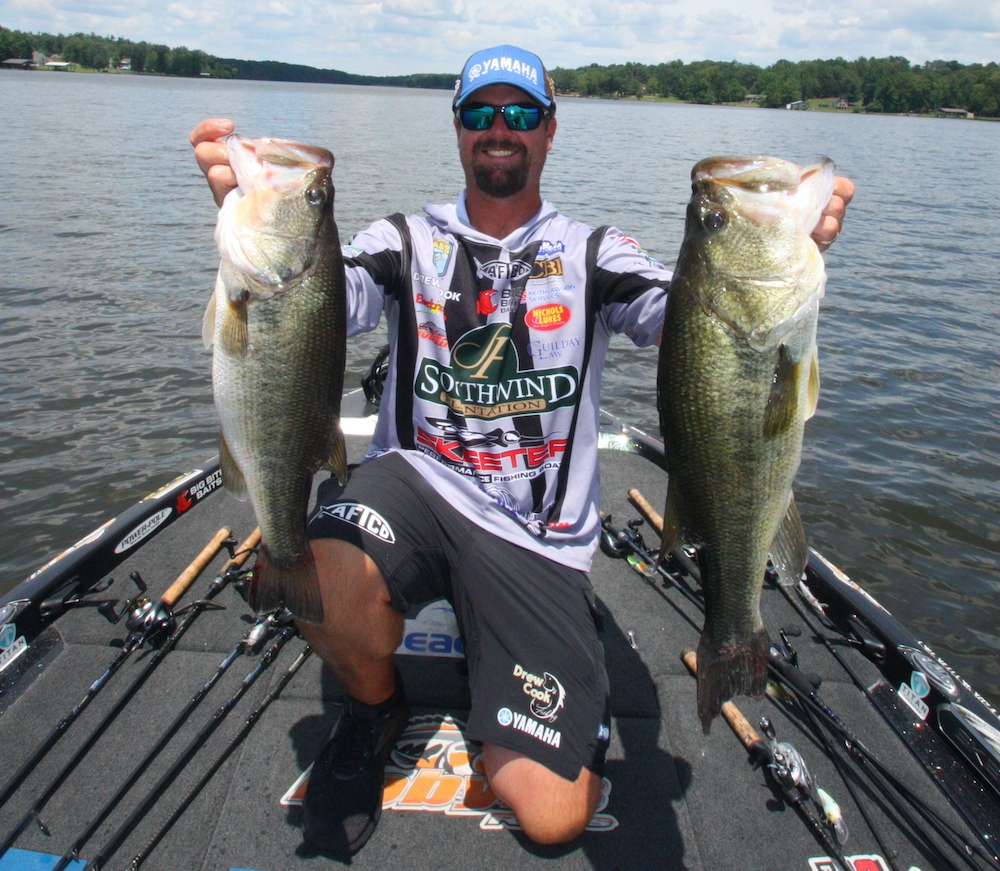
THE DAY IN PERSPECTIVEâ¨âAs I suspected, points proved to be the targets that held the most fish today,â Cook told Bassmaster. âLong, slow-tapering points with a lot of baitfish suspending around them far outproduced every other type of place I fished. I used a patient, wide-ranging approach when fishing these structures. Instead of pulling up right on top of the point, Iâd start out a long distance from it and gradually work my way closer while targeting baitfish schools, scattered cover and channel swings I encountered along the way, primarily with crankbaits. That 6-8 was probably a fluke; my gut tells me I could have spent the rest of the day flipping laydowns and not come up with another good fish. If I were to fish here tomorrow, Iâd spend way less time in shallow water and would check out a few more points using the same lures and long-ranging approach.â
WHERE AND WHEN DREW COOK CAUGHT HIS FIVE BIGGEST BASS
1. 2 pounds, 14 ounces; Spro Fat Papa 70 crankbait (homemade shad color); rock point; 7:48 a.m.
2. 6 pounds, 8 ounces; 1/2-ounce green pumpkin/chartreuse/orange Nichols Lures DB finesse jig with tilapia Big Bite Baits Fighting Frog trailer; laydown on channel bank; 10:59 a.m.
3. 2 pounds, 15 ounces; Spro RkCrawler crankbait (ayu color); mud point; 12:49 p.m.
4. 4 pounds, 9 ounces; Spro Fat Papa 70 crankbait (citrus shad color); same place as No. 3; 12:52 p.m.
5. 3 pounds; same lure as No. 2; same place as No. 3; 1:20 p.m.
TOTAL: 19 POUNDS, 14 OUNCES
